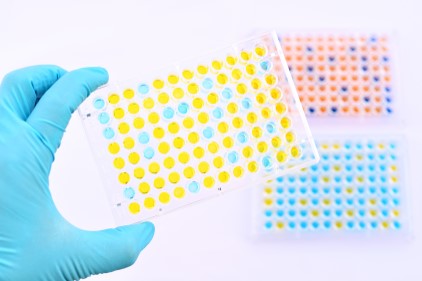This website uses cookies to ensure you get the best experience on our website.
- Table of Contents
In order to get the best results from your ELISA assay, the dilution factors of the sample and the detection antibodies must be optimized. If your sample or antibodies are too concentrated, you risk saturating the assay. If they are not concentrated enough, your signal will be weak and difficult to detect. For strong, quantifiable signal, use a checkerboard titration to test for the optimal...
Are you familiar with the multiple methods you could use to perform an ELISA? Among the standard assay formats illustrated below, where differences in both capture and detection are in concern, it is important to differentiate between the particular strategies that exist specifically for the detection step. However an antigen is captured to the
If you are having trouble with saturated signals in your ELISA data results, check out this table for Boster’s possible solutions to your problem:
| Possible Causes | Possible Solutions |
|---|---|
| High sample concentration | Use higher sample dilutions (Determine the optimal dilutions by titration assay) |
| Excessive substrate | Decrease concentration or amount of substrate: Follow manufacturer guidelines (The substrate provided with the ELISA kit might require further dilution) |
| Substrate color changed before use | Make substrate immediately before use |
| Non-specific antibody binding | Try different formulations in coating solutions; Ensure wells are pre-processed to prevent non-specific binding; Use affinity-purified antibody and preferably one that is pre- adsorbed; Use serum (5-10%) from same species as secondary antibody (bovine serum is also recommended). |
| Incubation time too long | Follow the manufacturer guidelines (If the problem persists, try incubating samples at 4°C overnight) |
| Excess antibody | Repeat the assay with lower antibody concentrations to find the optimal one for your experiment |
| Contaminated buffers with metals or HRP | Make and use fresh buffers |
| Insufficient washing | Follow the manufacturer guidelines; At the end of ea |
ELISA (enzyme-linked immunosorbent assay) is a plate-based assay used to detect the concentration of a specific protein in a liquid sample. Three different types of data output can be obtained:
To set up a standard curve, ELISA standards should be carefully prepared for accurate sample quantification of...
ELISA (enzyme-linked immunosorbent assay) is a convenient and simple method to quantitatively or qualitatively detect peptides, proteins, antibodies, and hormones in samples, rendering it as one of the most widely used immunoassays. Despite the many advantages of conducting ELISA, there are some mistakes that could turn your ELISA experiment sour. Help prevent this situation from happening by avoiding 5 common pitfalls when performing an ELISA:
1. “I think I still have some of the TMB coloring development agent from the previous kit. Maybe I’ll use that instead.”

Stop! Wanting to conserve resources is a good habit, but not in this case. We should avoid using reagents from different batches together. Each...
The ELISA (enzyme-linked immunosorbent assay) is recognized by scientists for its many advantages. The assay is convenient, quick, and simple to execute. ELISA’s versatility to detect peptides, proteins, antibodies, and hormones, and its ability to generate quantitative and qualitative data make it one of the most popular and powerful immunoassays available.
In response to popular demand, numerous commercial ELISA kits are offered in the market, but not all ELISA kits are created equal.
How do we sift through the masses and choose a good ELISA kit?
Keep in mind the following points next time you go hunting for an ELISA kit.
Stock up and save 50% off on 400+ PicoKine® ELISA kits! When placing your order for the eligible PicoKine® ELISA kits, submit the promo code 50%ELISA to apply the 50% discount.
Browse the promoted ELISA kits and claim your discount. We're extending our promotion until March 31, 2023, so take the opportunity to save BIG...
From September 7th to December 16th, you can get 50% off on 400+ PicoKine® ELISA kits! When placing your order for the eligible PicoKine® ELISA kits, submit the promo code 50%ELISA to apply the 50% discount.
Browse the promoted ELISA kits... and claim your discount. Take advantage of the promotion before it ends!Dilution ratio describes a simple dilution – a unit volume of solute (or sample) is combined with a desired unit volume of solvent (or diluent), to reach a desired total volume (Vsolute + Vsolvent = Total Vsolution)
Thus, a dilution ratio of 1:4 describes 1 part solute + 4 parts solvent = 5 parts total. The sum of both solute plus solvent equals total, f...